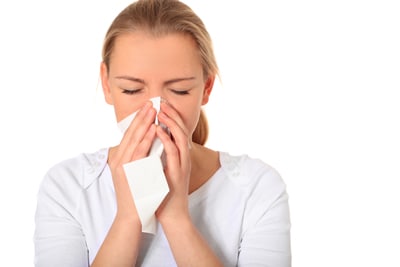Health Problems Related to Dampness and Mold

Allergies or allergic responses to pollen or animal dander are the most common types of health problems related to mold. Typical symptoms include:
- Sneezing
- Nose, mouth, or throat irritation
- Irritation of the nose, mouth, or throat
- Nasal stuffiness and runny nose
- Red, itchy, or watery eyes
Inhaling or touching mold or mold spores can cause a person to become allergic to mold. Molds can trigger asthma symptoms including shortness of breath, wheezing, or cough in people with known allergies. People who do not have allergies can also become irritated. Studies indicate that exposure to molds in the workplace can make pre-existing asthma worse. NIOSH investigates associations between damp buildings and developing new asthma.
Hypersensitivity pneumonitis (HP) is a kind of lung inflammation that occurs when people develop immune system sensitization to inhaled organic dust. Immune system sensitization is similar to an allergy. It can seem like pneumonia, but it does not get better with antibiotics for infection. Symptoms of HP can vary. Some persons have:
- Shortness of breath
- Cough
- Muscle aches
- Chills
- Fever
- Night sweats
- Profound fatigue
These symptoms usually first appear 2 to 9 hours after exposure and last for 1 to 3 days. Other affected persons have progressive shortness of breath and cough, as well as weight loss.
Work-relatedness may only become apparent over long holidays if symptoms resolve and then recur on return to work. With continued exposure, the persistent lung inflammation of both kinds of symptoms can lead to scarring and permanent damage. Symptoms that continue to develop away from work can cause delays for physicians or workers to recognize work-related lung disease.
Workers in occupations with exposures to biological dust have called HP bird breeder’s lung or mushroom picker’s disease. It has been documented in workers in buildings with mold and bacteria contaminated air-conditioners. This includes spray-water cooling systems (e.g., swamp coolers) and contaminated ductwork and filters.
This lung disease has also occurred in workers who worked in water-damaged buildings with:
- Roof leaks
- Plumbing leaks
- Poorly draining condensation pans
- High indoor relative humidity
HP is not contagious. It is due to a person’s immune system reaction to inhaled microorganisms, whether dead or alive. It is possible for workers to have both dampness-related HP and asthma at the same time. Additionally, workplaces that have workers with HP may also have workers with building-related asthma.
Asthma is a lung disease where the airways develop inflammation and constriction in response to sensitizing or irritating exposure. Affected individuals can experience:
- Shortness of breath
- Cough
- Chest tightness
- Wheezing
Symptoms occur after exposure to nonspecific substances in the air. They can also occur after exposure to substances an individual is allergic to. Medical testing typically reveals:
- Evidence of bronchial hyperresponsiveness (increased sensitivity) such as an abnormal methacholine challenge test.
- Reversible airways obstruction on spirometry (a test of lung function).
It is important for affected individuals to have a comprehensive asthma treatment plan and regular follow-up with their physician.
Early diagnosis and removal from the damp office environment can cure asthma caused by workplace exposures. Some exposures in the workplace are risks for developing asthma (e.g., western red cedar; isocyanates). Research shows evidence of an association between damp buildings and asthma symptoms in individuals with pre-existing asthma. There is also evidence of an association between damp buildings and new-onset asthma.
Workers may be able to identify related exposures by frequently measuring lung function. Measuring should occur several times a day at work and at home over several weeks. This may reveal a pattern of changing lung function.
Individuals who suspect their asthma relates to the indoor environment should control or eliminate sources of indoor contaminants. They should also seek medical treatment to improve or resolve symptoms.
